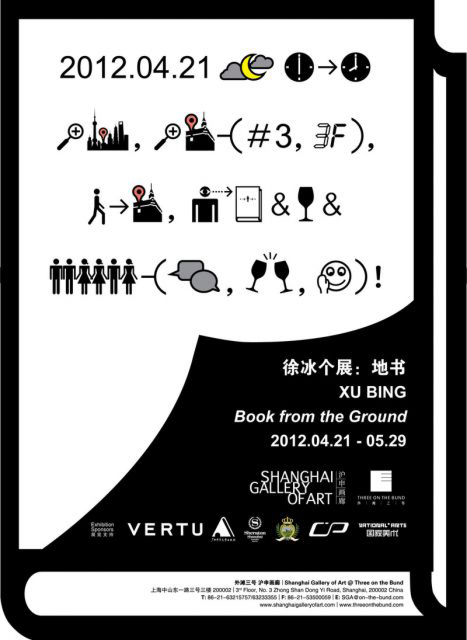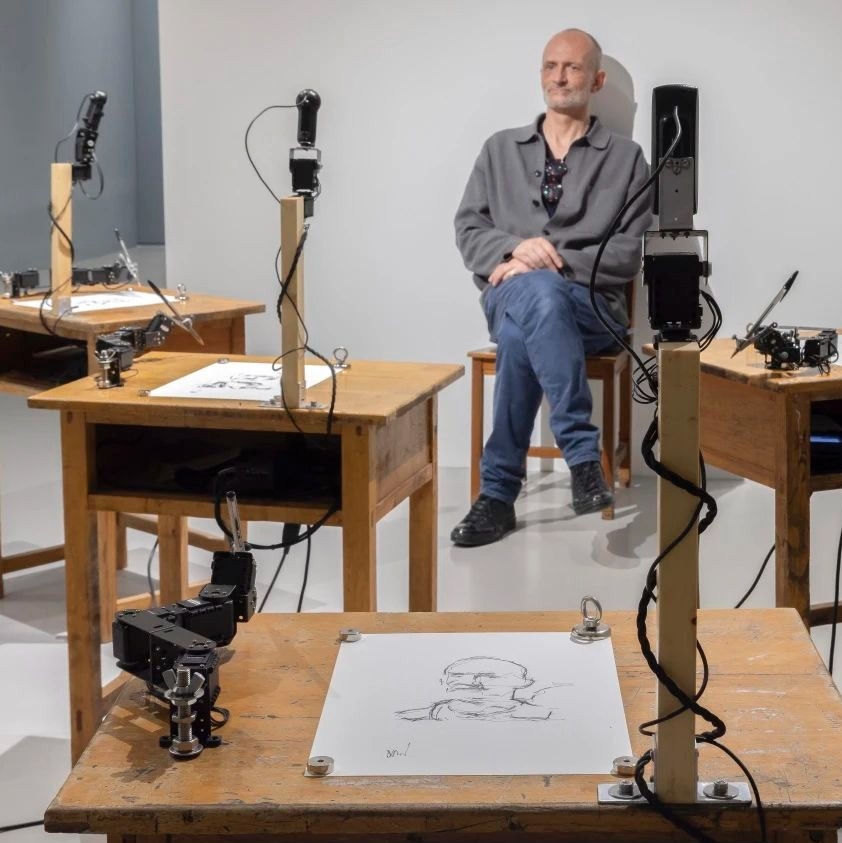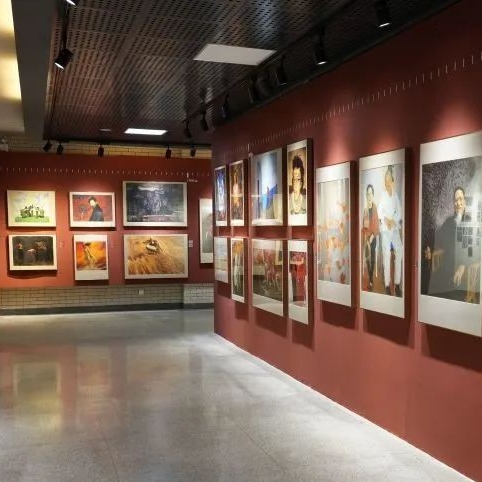
Xu Bing's new solo exhibition takes place at Shanghai Gallery of Art from April 21st through to May 29th, 2012 which coincides with the publication of his new work, Book from the Ground, a book that tells stories through the icons common to our contemporary experience. This work continues Xu’s longstanding interest in the link between the written symbol and visual communication. It highlights the text; showcasing works made in conjunction with the book, and at same time presents previous pieces which reveal the history of Xu’s engagement with these themes. Decoding of Xu's work through his own interpretation is as follows.
Regarding Book from the Ground
by Xu Bing
Book from the Ground is a novel written in a "language of icons" that I have been collecting and organizing over the last few years. Regardless of cultural background, one should be able understand the text as long as one is thoroughly entangled in modern life. We have also created a "font library" computer program to accompany the book. The user can type English sentences (tough this is limited, but the next step will include Chinese and other major languages) and the computer will instantaneously translate them into this language of icons. It can function as a "dictionary," and in the future it will have practical applications.[gallery link="file" orderby="title"]
This project first began with my collecting of safety manuals from a number of airlines. In the past decade, I have spent countless hours in airports and aboard planes. The design of airport signs and airline safety manuals is based upon image recognition. Diagrams there are employed as the primary means of communication in an attempt to explain relatively complex matters with a minimum of words. It was this that truly fascinated me. Since about 1999, I have collected over one hundred safety cards, but until recently I had no clear goal as to what I was going to do with them. Then, in 2003, I noticed three small images on a pack of gum (they translate into please use your wrapper to dispose of the gum in a trashcan), and came to realize that in so far as icons alone can explain something simple, they can also be used to narrate a longer story. From that point on, through various channels, I began to collect and organize logos, icons, and insignia from across the globe, and I also began to research the symbols of expression employed within the specialized fields of mathematics, chemistry, physics, drafting, musical composition, choreography, and corporate branding, among others. In recent years, the expanding speed of the Internet and the widespread emergence of a language of computer icons have greatly increased the scale and complexity of this project. But the more this becomes the case, the more I am able to sense the significance of this work, about which I have had the following thoughts:
In 1627, the French thinker Jean Douet, in an essay titled "Proposal to the King for a Universal Script, with Admirable Results, Very Useful to Everyone on Earth," first suggested that Chinese was a potential model for an international language. The word "model" is important here because Douet does not limit this "universal script" to the form of Chinese characters per se. He instead focuses on the universal potential of the system of recognition upon which the Chinese language is based. Today, nearly four hundred years later, human communication has indeed evolved in the direction predicted by Douet. We have come to sense that traditional spoken forms are no longer the most appropriate method for communication. And, in response, great human effort has been concentrated on developing ways to replace traditional written languages with icons and images. For this reason, among others, humankind has entered the age of reading images.
Most languages take shape among a small group of people (a tribe or a village) sharing a similar set of vocalized expressions. As the scope of the group’s activities expands, its language also develops into a regional mode of expression. The people’s geographic expansion across multiple localities and political boundaries is also the millennia-long process of its language’s growth. Today, spurred by a trend of internationalization, the world is contracting, creating the sense of a "global village." However, this huge "village" is distinct from the early villages out of which language first took shape: as citizens of the global village, we use a rich and varied range of dialects and often employ mutually incomprehensible systems of symbols to express information in a written form. We must, however, live and work together (in the sense that we share information on a global scale). As a result, the inconvenience of language and miscommunication has become a significant burden in many of our lives. Our existing languages are based on geography, ethnicity, and culture (including the all-powerful English), and all fall short. Written languages now face an entirely unprecedented challenge. Today, the age-old human desire for a "single script" has become a tangible need. This predicament requires a new form of communication better adapted to the circumstances of globalization. Only today can the implications of the Tower of Babel truly be revived.
The formation of nearly every language relies on two systems: phonetic and visual. Due to the wide range of phonetic systems currently in use throughout the world and the global trend of using evermore standardized goods, in addition to technological innovations such as the growing ease and speed of duplicating and sending visual data, it is thus natural (and necessary) to use images and pictographic icons as a means of communication. In truth, today’s "big village" has reignited the historical process of early linguistic development, beginning again with pictographs.
Let’s analyze existing phenomena:
The broadening range and increasing density of movement among peoples has impelled the rapid formation and use of a system of international icons. These symbols are most commonly found in areas of concentrated human density and diversity, and so it follows that the airport was among the first locales to make wide use of them. It could be said that along with airline safety cards, airport signs were the first "common-reader" texts. The airport epitomizes the global village, and, unconsciously, these texts have come to form an effective visual system of direction that transcends the written word.
The continued standardization of transnational products and consumer lifestyles, the growth of a "repetitive environment" and a "copy culture," and the daily accelerating homogenization of a global mode of living have rendered the visual form of things far more recognizable, and the growth of international media has further strengthened their symbolic quality. To a certain degree, this phenomenon has begun to eliminate illiteracy on a global scale and has resulted in the utilization of images as a basis for recognition and communication in contemporary life, making it much easier than in the past to reach a common understanding.
It can be said with certainty that anything aimed at a global audience must make use of a quick, effective mode of recognition and dissemination. Economic globalization demands direct commercial communication. Consequently, companies and products must employ corporate and product logos that transcend language and locality and possess clearly recognizable characteristics. Today, these logos appear everywhere, in high volume. Early attempts to market products to a global audience utilizes translation, but now multinational businesses are developing in the direction of wordlessness. Past Coca-Cola ad campaigns included text translated into the language of the customer. But three years ago, the Coca-Cola Company made a decision to present their brand name to the international market in the form of an image, and not as a word. From this, "Coca-Cola" became an image that requires no translation.
Numeric commands can now be represented as icons, thus turning a specialized vocabulary into an intuitive visual one; this, for our purposes, is the most significant development in personal computing. It has significantly lowered the base level of knowledge required to take advantage of a technology that "one must study in order to grasp." Now anyone can distinguish computer functions and operate programs. While the computerization of the workplace has, on the one hand, resulted in a degree of physical laziness and degeneration, it has also created a group of people and a physical and technological environment easily adapted to this pictographic age. This is reflected in a new generation of people who find themselves at loggerheads with traditional reading and captivated by intuitive graphics.
The ubiquity of the Internet and the convenience of ever faster trans-global communication and information sharing have further exposed the limitations of inter-language conversation. As a result, the language of icons, the Internet, and online gaming, consisting primarily of pictographs and images, has already emerged in great volume. This vocabulary is developing at lightning-quick speed, of its own accord, and is not bound by the geographical concepts of the past.
We at first overlooked the fact that practitioners of such fields as mathematics, design, drafting, music, and dance already use their own "international languages" to communicate with one another. But the international language of "everyday life" has yet to be found. In 1990 the International Organization for Standardization (ISO) announced the final version of the first group of fifty-five "Public Information Symbols." From 2001 to 2005, the ISO separately published guidelines for the design of symbols (for instance, what visual elements an unambiguous symbol must possess), how to use these symbols (to the point of specifying the use of arrows), etc. This can be seen as the embryonic form of a universal language for everyday life.
Humans have never abandoned the ideal of overcoming the obstacles of the written word, yet only under the favorable conditions of the "global village" has a turning point existed for such a system to emerge. The phenomena described above illustrate that a model based fundamentally on images, with the potential to surpass our current systems of writing, and drawing strength from a common desire, has clearly begun to appear. I have come to realize this trend and its possibilities.
As we collected and organized these images that are already in use and possess both a foundation of common recognition and the quality of language, we had one principle: not to engage in any subjective invention or fabrication, because most sound writing systems first arise from common usage and then take shape through a process of organization. We regard our set of previously organized symbols as a type of language because it has not been invented, fabricated, or defined by any particular person. Generally speaking, subjective, man-made symbols are personalized, lack a natural logic, and are not based upon a widely shared understanding. They cannot support easy recognition or repeated and uniform use. (This is also the reason that the cartoons cannot be considered a descriptive language.)
Every "word" in this system has its own source or origin. The "grammar" (including adjectives, person, tone, prepositions, etc.) is similarly a collection of widely used and commonly recognized "representations," which we have analyzed and compiled according to their visual and psychological indicia. All of these elements are pre-existing. I have only collected and organized them.
In certain respects, this language transcends our structures of knowledge and the limitations of geographic and cultural specificity; it reflects the logic of real life and objects themselves rather than any preexisting text-based knowledge. Comprehension is not contingent upon the reader’s level of education or knowledge of literature, but instead stems from his/her experiences and way of life. Moreover, this language need not be taught or learned through traditional educational models. Regardless of your cultural background or mother tongue, you will be able to read this book as long as you have experience of contemporary life. The educated and illiterate should be able to enjoy equally the pleasure of what it means to read.
In addition, after our currently un-finished computer program is perfected, writers of every language will be placed on equal footing. To a certain extent, this software will function as a point of transfer between dissimilar languages. This early result should not be minimized because it has limitless potential to expand into even larger arenas. The relationship between our new language and other, preexisting languages resembles the relationship between Mandarin and the many Chinese dialects: disparate pronunciations refer to identical characters. English cannot become a "global language," as its relationship with other languages is one of mutual exclusivity. As the use of English expands, other languages are lost. Michael Evamy states, "for now, the world’s peoples must either be addressed in their own language, or by non-verbal means." In that respect, a pictographic language not reliant upon phonics has a special advantage.
The success of a language is in the main dependent on the power of its political and economic force. Emperor Qin Shi eliminated the Six Kingdoms and unified the Chinese language; Mao popularized "standard" Mandarin characters through political means. Both revisions were undertaken with the aim of effectively communicating orders and unifying a country. This new system, the development of which I am now introducing to you, also draws its strength from political and economic factors but does not take the nation-state as its basic unit. It is rooted in the market rules of the global economy and world politics. Capital has become the new global language of power, but it must still undergo large-scale unification before it can more effectively control commerce.
It would be reasonable to expect that I use this new "language" to write an introduction. Unfortunately this is, as of yet, impossible. However, all languages begin at the most elementary level of communication and only later develop into a medium suitable for complex expression. In this process, major components of the original language are lost, and only small portions survive to form the languages we recognize today. Undoubtedly, this new language has only reached the oracle bone phase (the most rudimentary pictographic state). Yet, one cannot judge the potential of a language based on its current level of expressiveness. Instead one should consider its possibilities as a language of the future, and whether its linguistic DNA allows for its continued growth.
I believe that the significance of a work does not lie in its resemblance to art, but in its ability to present a new way of looking at things. I have created many works that relate to language. This subject first took shape twenty years ago with a piece called Book from the Sky. It was called Book from the Sky because it contained a text legible to no one on this earth (including myself). Today I have used this new "language of signs" to write a book that a speaker of any language can understand; I call it Book from the Ground. But, in truth, these two texts share something in common: regardless of your mother tongue or level of education, they strive to treat you equally. Book from the Sky was an expression of my doubts regarding extant written languages. Book from the Earth is the expression of my quest for the ideal of a single script. Perhaps the idea behind this project is too ambitious, but its significance rests in making the attempt.
New York
2006
Courtesy Xu Bing Studio, for further information on Book from the Ground, please visit www.bookfromtheground.com.
Website of Xu Bing Studio: http://www.xubing.com/index.php/.




























